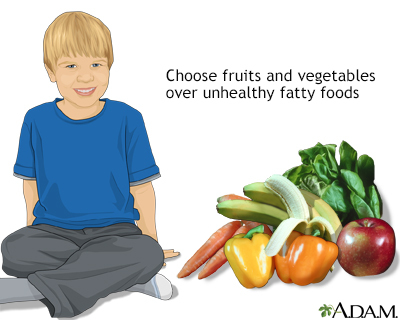Dietary fat and children
Alternative Names
Children and fat-free diets; Fat-free diet and children
Information
Some fat in the diet is needed for normal growth and development. However, many conditions such as obesity, heart disease, and diabetes are linked to eating too much fat or eating the wrong types of fat.
Children over age of 2 should be offered low-fat and nonfat foods.
Fat should NOT be restricted in babies under age 1.
- In children ages 1 and 3 years old, fat calories should make up 30% to 40% of total calories.
- In children age 4 and older, fat calories should make up 25% to 35% of total calories.
Most fat should come from polyunsaturated and monounsaturated fats. These include fats found in fish, nuts, and vegetable oils. Limit foods with saturated and trans fats (such as meats, full-fat dairy products, and processed foods).
Fruits and vegetables are healthy snack foods.
Children should be taught healthy eating habits early, so they may continue them throughout life.
Gallery

References
Ashworth A. Nutrition, food security, and health. In: Kliegman RM, St. Geme JW, Blum NJ, Shah SS, Tasker RC, Wilson KM, eds. Nelson Textbook of Pediatrics. 21st ed. Philadelphia, PA: Elsevier; 2020:chap 57.
Maqbool A, Parks EP, Shaikhkhalil A, Panganiban J, Mitchell JA, Stallings VA. Nutritional requirements. In: Kliegman RM, St Geme JW, Blum NJ, Shah SS, Tasker RC, Wilson KM, eds. Nelson Textbook of Pediatrics. 21st ed. Philadelphia, PA: Elsevier; 2020:chap 55.